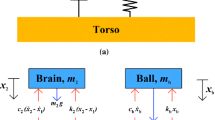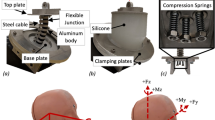Abstract
This study develops a dynamic model of head acceleration, which incorporates physiologically related neck muscle contributions, to further the understanding of the mechanical behaviour of the head-neck system during soccer heading. An inverted pendulum is combined with a linear visco-elastic element to model the head-neck system following a half-sine input force. Model parameter values were varied to obtain agreement with previously published experimental data (Naunheimet al., 2003), and were subsequently compared to literature values. The model predicted the same mechanical angular kinematics as observed experimentally both during and post impact. The greatest acceleration was in the anterior direction at the instant the ball left the head, attributed to the elastic stiffness of the neck musculature. The head-neck stiffness and damping coefficients determined from the model (350 N m rad-1 and 4 N m s rad-1, respectively) were similar to those reported elsewhere when subjects were asked to resist maximally. The model may be subsequently used to investigate differences in technique and ability with respect to the salient model parameters to further our biomechanical understanding of soccer heading.
Similar content being viewed by others
References
Bauer, J.A., Thomas, T.S., Cauraugh, J.H., Kaminski, T.W. & Haas, C.J. (2001) Impact forces and neck muscle activity in heading by collegiate female soccer players.Journal of Sports Sciences,19, 171–179.
Bogduk, N. & Mercer, S. (2000) Biomechanics of the cervical spine. I: Normal kinematics.Clinical Biomechanics,15, 633–648.
Burslem, I. & Lees, A. (1988) Quantification of impact accelerations of the head during the heading of a football. In:Science and Football (eds T. Reilly, A. Lees, K. Davids & W.J. Murphy), pp. 243–248. E & FN Spon, London, UK.
Chandler, R. F., Clauser, C. E., McConville, J. T., Reynolds, H. M. & Young, J. W. (1975) Investigation of inertial properties of the human body. AMRL-TR-74-137, AD-A016-485. DOT-HS-801-430. Aerospace Medical Research Laboratories, Wright-Patterson Air Force Base, Ohio, USA.
De Ruiter, C.J., Didden, W.J.M., Jones, D.A. & De Haan, A. (2000) The force-velocity relationship of human adductor pollicis muscle during stretch and the effects of fatigue.Journal of Physiology, 526.3, 671–681.
Edman, K.A.P., Elzinga, G. & Noble, M.I.M. (1978) Enhancement of mechanical perfomance by stretch during tetanic contractions of vertebrate skeletal muscle fibres.Journal of Physiology,281, 139–155.
Goldsmith, W. & Plunkett, J. (2004) A biomechanical analysis of the causes of traumatic brain injury in infants and children.The American Journal of Forensic Medicine & Pathology,25, 2, 89–100.
Kartal, A., Yildiran, I., Senköylu, A & Korkusuz, F. (2004) Soccer causes degenerative changes in the cervical spine.European Spine Journal,13, 76–82.
Kirkendall, D.T., Jordan, S.E. & Garrett, W.E. (2001) Heading and head injuries in soccer.Sports Medicine,31, 369–386.
Levendusky, T.A., Armstrong, C.W., Eck, J.S., Jeziorowski, J. & Kugler, L. (1988) Impact characteristics of two types of soccer balls. In:Science and Football (eds T. Reilly, A. Lees, K. Davids and W.J. Murphy), pp. 385–393. E & FN Spon, London, UK.
Matser, J.T., Kessels, A.G.H., Lezak, M.D., Jordan, B.D. & Troost, J. (1999) Neuropsychological impairment in amateur soccer players.Journal of the American Medical Association,282, 971–973.
McCrory, P. (2003) Brain injury and heading in soccer.British Medical Journal,327, 351–352.
Naunheim, R.S., Bayly, P.V., Staneven, J., Neubauer, J.S., Lewis, L.M. & Genin, G.M. (2003) Linear and angular head accelerations during heading of a soccer ball.Medicine & Science in Sports & Exercise,35, 1406–1412.
Noble, M.I.M. (1992) Enhancement of mechanical performance of striated muscle by stretch during contraction.Experimental Physiology,77, 539–552.
Queen, R.M., Weinhold, P.S., Kirkendall, D.T. & Yu, B. (2003) Theoretical study of the effect of ball properties on impact force in soccer heading.Medicine & Science in Sports & Exercise,35, 2069–2076.
Reid, S.E., Raviv, G., & Reid, S.E. Jr (1981) Neck muscle resistance to head impact.Aviation, Space & Environmental Medicine,52, 2, 78–84.
Schneider, K. & Zernicke, R.F. (1988) Computer simulation of head impact: Estimation of head-injury risk during soccer heading.International Journal of Sports Biomechanics,4 358–371.
Stålnacke, B.-M., Tegner, Y & Sojka, P. (2004) Playing soccer increases serum concentrations of the biochemical markers of brain damage S-100B and neuron specific enolase in elite players: a pilot study.Brain Injury,18, 899–909.
Tierney, R.T., Sitler, M.R., Buz Swanik, C., Swanik, K.A., Higgins, M. & Torg, J. (2005) Gender differences in head-neck segment dynamic stabilization during head acceleration.Medicine & Science in Sports & Exercise,37, 272–279.
Tysvaer, A.T. & Storli, O. (1981) Association football injuries to the brain: a preliminary report.British Journal of Sports Medicine,15, 163–166.
Tysvaer, A.T. & Lochen, E.A. (1991) Soccer injuries to the brain. A neuropsychological study of former soccer players.American Journal of Sports Medicine,19, 56–60.
Webbe, F.M. & Ochs, S.R. (2003) Recency and frequency of soccer heading interact to decrease neurocognitive performance.Applied Neuropsychology,10, 31–41.
Woltring, H.J., Long, K., Osterbauer, P.J. & Fuhr, A.W. (1994) Instantaneous helical axis estimation from 3D video data in neck kinematics for whiplash diagnostics.Journal of Biomechanics,27, 1415–1432.
Author information
Authors and Affiliations
Corresponding author
Rights and permissions
About this article
Cite this article
Riches, P.E. A dynamic model of the head acceleration associated with heading a soccer ball. Sports Eng 9, 39–47 (2006). https://doi.org/10.1007/BF02844261
Issue Date:
DOI: https://doi.org/10.1007/BF02844261




